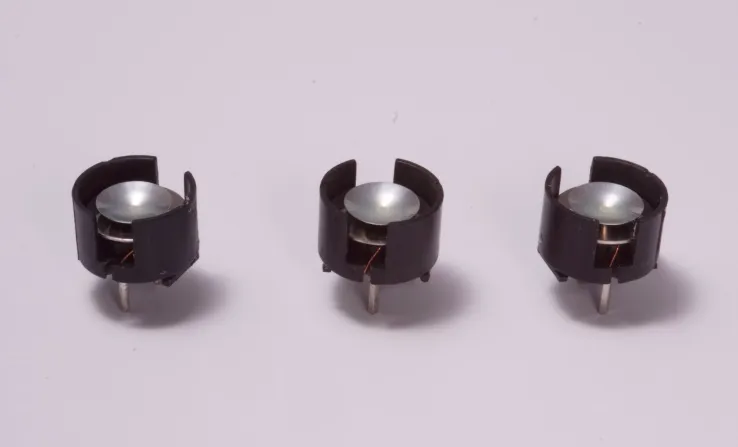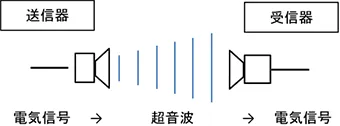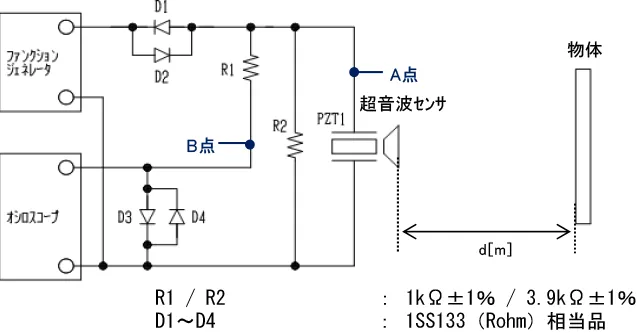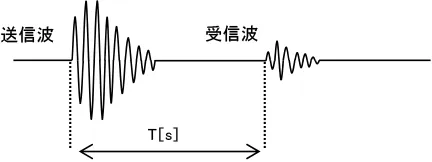
Ultrasonic sensor SE-40A1
An ultrasonic sensor is a contactless sensor that uses ultrasonic waves as the detection medium.
Product Features
- Using ultrasonic waves as a detection medium, it can detect the presence or absence of an object and the distance to the object without contact.
Main Applications
Airborne ultrasonic sensors

An ultrasonic sensor is a contactless sensor that uses ultrasonic waves as the detection medium. Practically, it consists of a transmitter and a receiver; the transmitter uses ultrasonic waves converted from electrical signals as the medium for transmission, and the receiver converts the received ultrasonic waves to electrical signals.
Generally, the transmitter emits ultrasonic waves towards an object, and the receiver receives the reflected waves, so that the existence of and the distance from the object can be identified.
Operating principle

Piezoelectric ceramics are capable of converting mechanical energy to electrical energy (piezoelectric effect) and electrical energy to mechanical energy (inverse piezoelectric effect). The piezoelectric effect and inverse piezoelectric effect allow the transmission and reception of ultrasonic waves.
When voltage is applied to a piezoelectric ceramic, it expands and contracts in the thickness direction and, accordingly, in the direction perpendicular to the thickness.

Structure and dimensions
Structure

1 Piezo & Transducer
2 Case (plastic resin)
3 Terminals
4 Vibrating plate (metal plate)
5 Equalizer (metal)
6 Lead wire
7 Adhesive
8 Coating material
Dimensions

Specifications
| Item | Standard, etc |
|---|---|
| Structure | Open type |
| Usage | For both transmission and reception |
| Center frequency | 38.5 kHz±2.5% |
| apacitance | 2000 pF±20% |
| Max. input voltage | 30 Vpp |
| Sensing distance | 0.2~4m |
| Operating temperature and humidity range | -40~85℃ 85% RH or less |
| Storage temperature and humidity range | -40~85℃ 85%85% RH or less(There must be no condensation) |
| Weight | About 0.6g |
- ※Please note that specifications are subject to change without notice.
Environment testing
| Test items | Conditions | Time |
|---|---|---|
| High-temperature exposure | +85℃ | 100 hours |
| High-temperature and humidity exposure | +85℃ 85%RH | 100 hours |
| Low-temperature exposure | -40℃ | 100 hours |
| Thermal shock | -40°C (30 min.) <=> +85°C (30 min.) (Short between terminals 1 and 2) | 100 cycles |
| Vibration | Maximum amplitude: 1.2 mm; frequency: 10 to 20 Hz | Two hours each for three directions |
| Room-temperature operation | Frequency: 40 kHz; block pulse: 30Vp-p | 1,000 hours |
Operating circuit [Example]
Measurement of the distance to an object (measurement of pulse reflection time)
The distance to an object is measured by measuring the time between the emission of ultrasonic waves from the ultrasonic sensor towards the object and the return of the reflected wave.
Pulse oscillator circuit [for both transmission and reception]

Transmitted waveforms
- Oscillating frequency/40 kHz, block pulse (voltage: 10Vpp)
- Burst cycle/10 ms
- On-duty/4%

Measurement method
The voltages of transmitted and received waveforms are measured using an oscilloscope.
Measurement locations: transmitted waveforms‒Point A, received waveforms‒Point B

The aerial ultrasonic wave propagation velocity V [m/s] is represented by the following equation.
V = 331.5 + 0.6071t (t: ambient temperature)
T [s], the time between the emission of ultrasonic waves and the return of reflected waves, is represented by the following equation, where d [m] is the distance from the ultrasonic sensor to the object.
T = 2d / V
Thus, the distance from the ultrasonic sensor to the object can be measured.
Notes of caution concerning circuit design
- Do not apply direct voltage (bias voltage) because doing so may degrade the properties.
- Care must be taken in circuit design because drop impact or thermal shock will cause a surge voltage.
- When mounting this product on a substrate, take into account vibration from the terminal on the transmission side.
- If there are undesired effects such as an increase in reverberation time, take measures such as providing the sensor with an acoustic absorbent or buffer material.
- 本Devices that incorporate this product must be designed so that safety is ensured even if the properties of this product are degraded or if this product ceases to operate.
Notes of caution concerning substrate
- Do not wash this product.
- This product is not compatible with flow or reflow soldering.
- When soldering the terminals, use a soldering iron at 300°C or lower applied for a maximum of three seconds.
- When soldering the terminals, do not apply force to them.
Notes of caution concerning usage
- This product is an airborne sensor, and cannot be used in water.
- Since this product is made of ceramic, subjecting it to excessive mechanical shock or vibration may result in its failure. Sufficient care must be taken in its handling. Also, do not use a product that has been dropped.
- Parts of this product (lead wire, equalizer) have rather low strength in order to attain its characteristics. Sufficient care must be taken in its handling.
- Care must be taken when stacking, storing, or handling substrates on which this product is mounted, because excessive pressure or impact may cause damage to the substrate.
- Since this product has directionality, its sensitivity varies depending on how it is fitted to the device or on where it is.
- This product must be used at an ambient temperature in the range of -40 to 85°C and a relative humidity of 85% or less in an atmosphere with no harmful gases such as chlorine gas, hydrochloric gas, sulfurous acid gas, and hydrogen sulfide gas.
- If condensation occurs during the use of this product, a short circuit may occur between the electrodes as a result of migration. Therefore, use this product in an environment with no condensation.
- Do not store or use this product in an environment with much dust or where it can become wet.
Contact & Download Materials
Suitable products are proposed to meet your specific needs. Feel free to contact us for more information.
Search for Products
Search by Keywords
